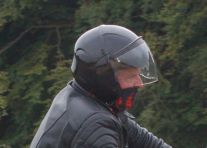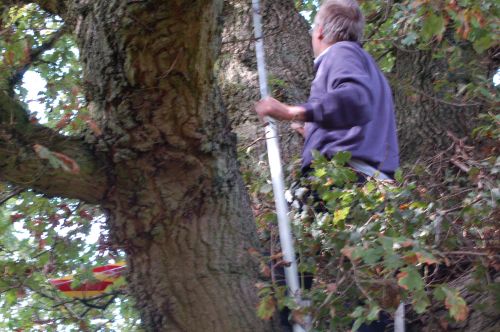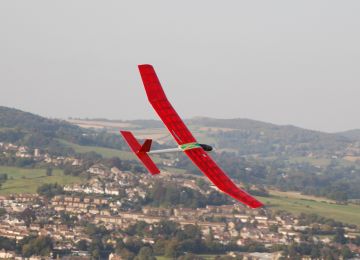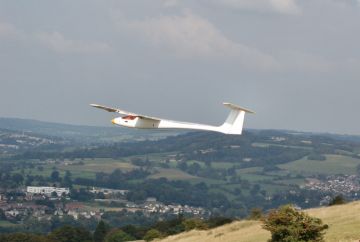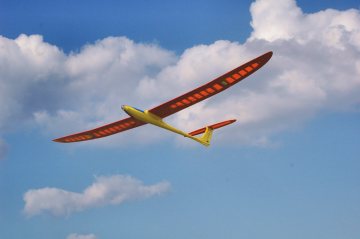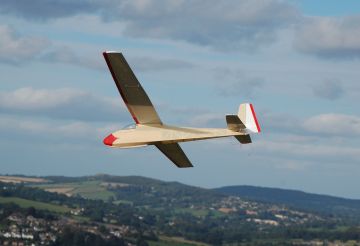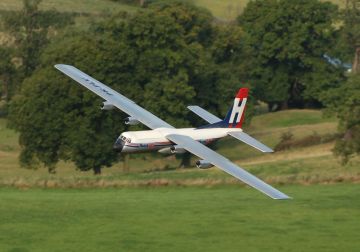Please send photos in full resolution as Jpegs with minimum compression and no adjustments, text is best with paragraphs but no carriage returns. |
|
It has been another good week of flying and I have received
and taken lots of photos, John Fairbairn sent me some photos of a fire
fighting
plane dropping water on a forest fire in France. John's stills from
his video camera are at http://www.scsa.org.uk/news/Hi.eml
1.2 megs Photo folder at http://www.ebley.plus.com/limbo/?M=D F3K NEWS
As some of you already know, I stepped down as the F3K
rep/league organiser last week, as I do not feel I can carry out the
role successfully in the current climate of endless debate,
questioning and petty politics by a vocal minority.
At the end of the day I have tried my best to progress F3K in UK and
help UK F3K pilots with the introductory planning for a new BMFA F3K rulebook,
a new BMFA league and team selection in 2008 as well as changes
to CIAM rules. However, I now wish to focus on enjoying my flying
activities without the ongoing pressures, which have sadly turned the
role into a thankless and extremely time consuming task. This is a disappointing
situation and I am sorry to those who have supported me, for this
reversing of my previous decission and the disruption this may cause the
2008 F3K league.
It is vital somebody else now steps forward to take on the role.
Without a F3K rep and F3K league organiser taking proactive action,
working with BARCS and the SFTC, it is very unlikely there will be a
formal F3K league and UK F3K team selection process in 2008 (meaning
we will have no team to send to anu international eventys in 2009). There
are a number of actions and documents that must be progressed in the next
few weeks with BARCS and the SFTC, to enable a 2008 F3K league calendar,
so time is very short.
I would ask any interested persons to contact Robin Sleight of BARCS (in
the first instance) to register their interest.
Best regards,
Chris Gibbs,
Reply By CB
Chris
Sounds like hand launch has reached TRUE "F" status at last.
Now it can take it rightful places along with all the other "F"
classes that we are no "f*****g" good at, but have achieved
world domination at the ability to bicker endless about how they should
be run.
Best of luck
Chris Bishop
|
|
Ken Sysson injured his hand with an electric prop about three weeks ago. The prop cut through several tendons and Ken's finger may not fully heal. It is a little frightening seeing what damage a small motor can do with one of these thin electric props. Take care, remember they can glitch on, I keep nkocking the the throttle on when I pick up my model.
Wanted
2 metre or near moulded slope soarer, reply to news letter
New local weather station http://www.severnbore.ndirect.co.uk/ have a look
Found electric glider near Amberley 13/09/07
Club meeting 19th September, details later
Indoor
flying in Gloucestershire. Venue
the main sports hall Chosen Hill School, Brookfield Road, Churchdown, Glos.
GL3 2PL. Opening
evening Saturday 22nd September 2007 6.00pm
until 8.00pm. Following
the success of these evenings during the winter and spring of 2007 we are
getting underway with the 2007/2008 indoor season. Indoor sessions will
take place fortnightly, but these may become weekly depending on demand. Dates
for the autumn/winter 2007 are: Saturday
22nd September, Saturday
6th & 20th October, Saturday
3rd & 17th November, Saturday
1st,15th & 29th December For
all past indoor sessions see reports plus of course our own highly and
critically acclaimed “documentary” http://www.glos-mfc.co.uk/index.html Indoor Flying at Bristol
Grammar School post code BS8 1SR map 14th October West Mendip Soaring cross country WMSA
Foker Tri-plane large
photo
s you see from the photograph taken a nano second after take off, things were lively from the start.
After breaking contact with the ground its
nose went up and started rolling left so I 'gunned it' on the
throttle to get it to altitude. It was a bit of hand
full, I think the CofG could come forward a bit and apply exponential to
soften its sharp edges. A DR1 has no dihedral and a small wing span so
it needs flying all the time from a roll aspect.
Loops and a roll was performed with ease and
you can hear Manfreds scarf flapping in the wind (I'm not kidding)
The stall from straight and level was very
hard to decipher it eventually dropped a wing but no real vices in this
department.
We could hear a noise that sounded like the
prop slipping was a landing was called for to check things out.
With power off it comes down..... fast,
probably due to all the drag so the landing was a bit fast,
with a little bounce before tripping over a clump of grass.
|
|
Calamity
There was no obvious damage from the nose
over. I checked the power at full throttle on the ground and the motor
decided to part company with the firewall resulting in a damaged
cowling. Further investigation reveals this as a weak point, the ply
motor mount is glued to a pair of balsa bearers which I think are a bit
feeble for the task, this small contact area takes all the load between
the motor and everything else. A bit of Bismark engineering is called
for.
Frankly I think a lot of these type of
electric models are very overpowered, I also flew the Miss 2 on
Wednesday which although a vintage model which would prop
hang if it had ailerons.
|
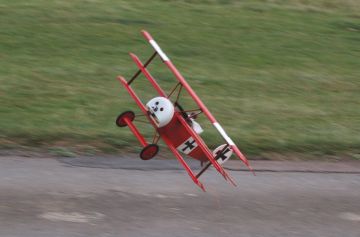
|
|
The DR1 is a nice model and I look forward
to having another go.
Below is an extract from experience of a
real DR1, there seem to be similarities!
The Triplane has some interesting flying characteristics and this article will attempt to describe them. Michael Editor
Below is an extract from experience of a
real DR1, there seem to be similarities!
The Triplane has some interesting flying characteristics and this article will attempt to describe them. Data Sheets and Information Refer to Tables 1, 2 and 3 for the so-called "numbers" on a Fokker Triplane. Bear in mind that the project is an exact replica of the WWI original with respect to size, dimensions, rigging, control movements, etc. We tried to build a replica without any compromises in the original configuration. The only modern components we have are a tailwheel instead of the original skid, a Warner 165 instead of the original Oberusel rotary engine, and brakes for the wheels. Otherwise, our replica is the same as flown in the 1917 WWI period. Taxi and Take-Off The combination of round cowl, nose-high ground attitude and mid-wing position of one of the wings make the Triplane virtually "blind" on the ground. Lots of S-turns and maneuvering are required. To avoid noseovers we have the brakes set very lightly. They only hold up to about 1200 rpm so braking is marginal and for steering only. Turns have to be planned well in advance. Gary and I now know why the mid-wing has the half-moon cutouts near the fuselage (so you can see). If you go slow and easy there is really no problem in taxiing and ground handling. The take-off run is sometimes exciting because you can’t see straight ahead at the start. I give it full power, stick all the way back and peek along the fuselage or sight on a cloud for initial direction. The Triplane accelerates very quickly and the tail can be lifted at about 30 mph. Take-off is at around 40 mph after 250 to 300 feet ground run. Visibility is excellent once the tail is up and you can see over the nose. We have a nice rate of climb of 1500 ft./minute at 70 mph so you can fly some tight patterns. In any kind of a crosswind it’s best to keep the tail on the ground until speed is reached and then "pop" the tail up into the flying attitude. Take-offs present no special problem other than visibility at the start of the ground run. Flight Characteristics The first thing you notice about a Triplane is that it is definitely a "rudder" airplane and you have to keep on the pedals constantly to keep the ball in the center of the slip-skid indicator. The elevator is excellent with smooth, powerful responses at all speeds. The ailerons are somewhat heavy but I consider the roll control good. There is a large amount of adverse yaw since there is little aileron differential. If the ailerons are quickly displaced, the Triplane will yaw 20 to 300 if rudder connection is not applied. The rudder control tends to be marginal. All turns must be coordinated and the ball really rolls around the cage during a turn. Turns are not very stable and I have to constantly work the rudder to keep them coordinated. Only a slight amount of back pressure is needed during turns, even steep ones. At cruise speed of 90-95 mph, the Triplane is very nimble, quick and responsive. You can really move it around if you keep on the rudder. The Triplane tends to fly tail heavy and increasing speed requires lots of forward stick to hold the nose down~ It appears as if the effective center of drag is above the thrust line so the faster you go the more elevator correction is needed to hold the nose down. This is somewhat of an explanation for the familiar "tuck" position of the Triplane at high speed. The horizontal stabilizer is rigged at a plus 90 (leading edge high) but even with this forward stick pressure is needed as speed increases. The high lift wing airfoil shape really wants to pull the plane up. All the wings are rigged at 11/20 angle of incidence. Stalls occur at about 40-45 mph and the Triplane "mushes" down without a definite nose break. It is a little like a parachute in descending. General visibility is excellent except for the mid-wing placement. In the traffic pattern you have to "bob" the nose up and down to keep visibility. Otherwise, the cockpit is comfortable, roomy and lots of fun to fly. Landings Here is where the real adventures begin. Approaches are made at 70 mph and visibility is excellent over the nose. With its high lift/drag configuration the Triplane really comes down steeply at about 1800 ft./minute in a "glide". I use wheel type landings at 95% of the time since it’s the only way to see. I only try full stall landings in a dead calm. Once the wheels are on the ground, I hold the nose up, slow it down, and then pull back the stick to get the tail planted and firmly on the ground. When the 3 wings stall out and the tail starts to come down, the rudder is effectively blanked out and directional control disappears. With the marginal rudder control you are essentially a passenger during the "twilight zone" of transition between flying and rolling. So, when the tail comes down, it’s best to be headed in the right direction. Fortunately, the slow landing speed of 40 mph makes for short landing distances. With any kind of a headwind, the Triplane stops in 250 to 300 feet after touchdown. Crosswind landings are very difficult to impossible to handle. With any kind of crosswind component (3 to 5 mph) these exercises are a real adventure. Before I flew the Triplane, I got lots of advice from the old pros Walt Redfern and Jim Appleby on how to handle this. The consensus on crosswind landing seems to be as follows: a) Keep it in the hangar if a crosswind is there. b) Always land into the wind. Land diagonally, off to the side, on taxiways, aprons, etc., to minimize the crosswind component. Our home field has a 200 ft. wide grass strip and most landings are on a diagonal directly into the wind. c) As a last resort, land on the downwind side of the runway with a wheel landing, slow it down and let it weathervane up into the wind then the tail comes down. With the large wing area and wide fuselage it will weathervane. My EAA associates in the Houston area kid me by saying with the short fuselage, small rudder, aft CG and large side area, I have "everything working for me" on landings. I now know why the original Triplane has the wing tip skids on the lower wing. However, once the tailwheel is on the ground at low speed, good control returns. The transition zone from flying to rolling is the dicey area. Sometimes you can use cross-control techniques on the landings by using the "down aileron" as a speed brake to help directional control. In summary, every landing is a real experience especially in any kind of crosswind. Primary Aerobatics Gary and I have taken the Triplane to numerous Texas Gulf Coast air shows and we have tried some primary aerobatics with it. Bear in mind that the following comments are from the perspective of private pilots with 600 hours flying time. We do not consider ourselves experienced in aerobatics and we stick to the basics. Loops — Loops are easy and fun in a Triplane. From cruise condition drop the nose to pick up 110 to 115 mph entry speed. A smooth back pressure of 3 G’s produces an amazingly tight loop. With the high drag, it is very easy to control it on the down side coming out. Caution: Keep the ball in the center or it can really come out of the loop cockeyed. Hammerheads — This is another good maneuver. With entry speed of 110 and a 3 G pull up you go straight up with good control. Rudder kick at the top produces a kind of pirouette rather than a turn and you come straight down. The high drag of the wings ooming down makes exits easy and quarter rolls can easily be done coming out of the Hammerhead. Rolls — The Triplane can be rolled but this maneuver gets difficult due to the differences in the control sensitivities of elevator, aileron and rudder. The best way seems to be to use high speed entry of 110, nose up 30º, full aileron and hope for the best. Lots of rudder correction is needed to overcome the adverse yaw. Once the roll starts indiscriminate use of the rudder or elevator will quickly stop the roll with some interesting results. The best rolls seem to happen when you use very little corrections once a roll starts. Big barrel rolls also seem to be better than rolling on a point. Slow rolls are very difficult because of the control sensitivity. The bottom line is, keep it fast and quick with lots of altitude for corrections if you fall out of one. Split-S — This is another easy maneuver. With its quick response, the Triplane comes quickly around. Sometimes I can build up airspeed to 110 mph, haul the nose up 300, half roll at 80 mph and exit in the opposite direction at entry altitude. Immelmans — Tough to do because of low speed at the top of the loop. The high lift/drag airfols really slow down at high angles of attack. Inverted Flight, Negative G’s, Tall Slides, Snaps, Etc. — These maneuvers are totally unsuitable for a Triplane. It is not configured to try any of these. Conclusion The best description of flying a Triplane is that it is "fun after the first frightening hour". Once you get used to its characteristics and quirks, it does very well, provided you keep within its limitations. It is desirable to stay well inside the flight envelope. It is easy to see why it has the reputation of being quick and nimble. It is also easy to see why WWI airfields were all round or square with the wind sock in the middle. If you always land into the wind, the Triplane is reasonably easy to live with and a lot of fun.
|
|
| We haven't seen this man for a while, click the image for the whole picture of this man in black | |
|
|
|
I think that I shall never see
A poem lovely as a tree.
A tree whose hungry mouth is prest
Against the earth's sweet flowing breast;
A tree that looks at God all day,
And lifts her leafy arms to pray;
A tree that may in Summer wear
A nest of robins in her hair;
Upon whose bosom snow has lain;
Who intimately lives with rain.
Poems are made by fools like me,
But only God can make a tree.
-- Joyce Kilmer
Don't mention trees to Mike, we spent two and half hours struggling to get Bob's model out of one of the large oaks at Frocester. Should the club buy a chain saw or give free flying lessons? It could have been worse read this article http://www.scsa.org.uk/articles/land_frocester.htm |
|
|
Monday and still the wind is on Selsley and quite strong. Only two scale models flown in spite of the ideal conditions. The wind eased a little in the evening. I flew my ASW20 after a trip home to pick up a servo that had failed. Ade flew his Discus2 photo Photo Peter flying an elderly Sid King Topline, a great model |
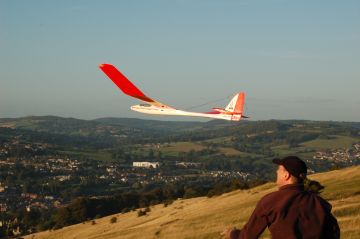
|
|
Tuesday. A light wind day, with some good lift, Mike's Valero in the photo out flew
my Pegase 1/4 scale. Selsley can be strange sometimes good lift with little wind and other days it's windy with no lift |
|
|
|
|
|
|
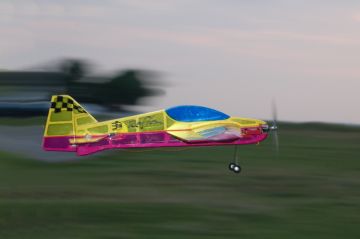 |
|
Terry O'Neal's slope soarer Wednesday afternoon. The afternoon started well, but the wind went to NE about 4.00PM and spoilt the lift. |
Brian's model at Wednesday evening's electric session. The wind dropped in the evening, perfect for light weight electric jobbies. Michael's Foker tri-plane looked great but hard to fly. see the hairy take-off http://www.ebley.plus.com/limbo/michael-tri-plane.jpg There are more photos of this session at http://www.ebley.plus.com/limbo/?M=D dated 12-Sep-2007 |
|
|
Thursday afternoon on Minchinhampton common, some big thermals but far apart, I got into two big ones with my Highlight Photo Guy's Riechard Champion, a little on the heavy side with the ni-cad pack |
|
A strong wind at Selsley on Friday, but coming from the point made it difficult
to get past the ridge and into the better air. Tim's Swing went well
carrying half ballast, My unballasted Nyx struggled for penetration. Phil Wright's Mirij looked fast and his Skylark in the photo coped OK with conditions. Alan's K8 went up so high Alan had to spin it down. I had a near miss with Alan's K8, I used full down as avoiding action, see photo http://www.ebley.plus.com/limbo/Near-hit-selsley.jpg |
|
| Saturday morning I went to Minchinhampton common
with my Highlight electric, a 10 sec motor run got me into smooth lift
over the reservoir which took me up OK but I had to chase it down wind
after gaining some good height I headed south up wind and picked up some
more lift over the pub, when Ken arrived I landed and watched his
Spitfire and Gemini fly. The Spitfire photo is a bit too sharp , they
look more realistic with a bit of blur. Spitfire photo The afternoon was spent at Frocester, good thermal lift but the slope lift faded at times. I flew Peter's ASW27 a great model, fast and aerobatic |
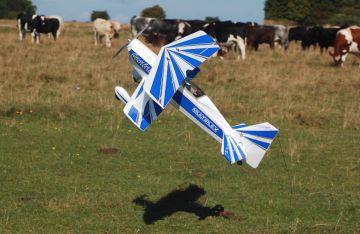 |
|
|
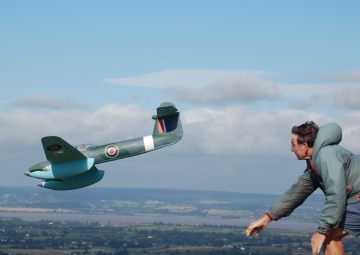 |
|
Mike's Hercules |
Bryan launching Doug's Whirlwind |
| Sunday at Frocester, The wind was really on Haresfield but we stayed at Frocester and suffered with bad lift at times as the wind swung more to the south. Peter had some good flying with his ASW28 and Bryan's ASW27 preformed well with a couple of landings right at the top of the slope. Three PSS models flown including Mike's EPP Mustang . Doug's Westland Whirlwind made two heavy landings, we think it is nose heavy because of the poor elevator response. I had the last unlucky flight and ended up a tree with my ASW20 | |
| For more photos go t http://www.scsa.org.uk/photos/phil/photopage.htm the pages have been added to since last week |
